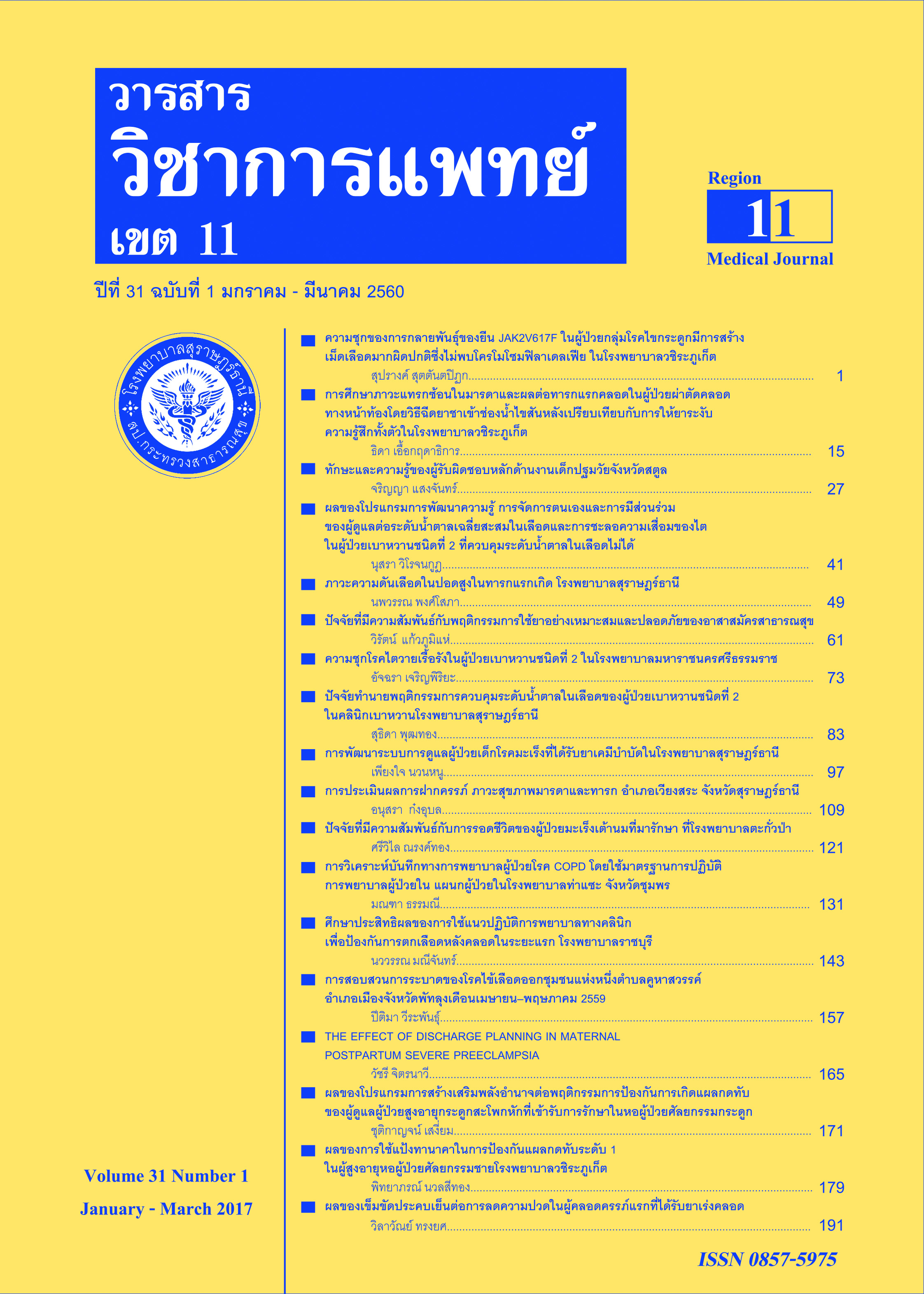Predictive factors on the Plasma Glucose Level in Type 2 Diabetes Mellitus client : Relative analysis under The theory of planned Behavior In SuratThani Hospital
Keywords:
patients with type 2 diabetes, behavioral intention, behavioral control blood sugar, multiple regressionAbstract
This research is Cross-sectional descriptive relative research. The purpose is to predict behavioral intention to control blood sugar in patients with type 2 diabetes by beliefs about the behavior consisting Attitude The Norm and perceive behavioral control in controlling behavior. A contingent of 140 samples were selected from those who visit the clinic diabetes.,Surat Thani Hospital .Data collected using personal interviews. Beliefs about behavior control blood sugar, the researchers created using the theory of planned behavior of Ajzen (1991), and behavior control blood sugar. Correlation analysis using Pearson correlation coefficient. Analyze and predict behavioral intention to control blood sugar by using multiple regression equations to predict variables simultaneously (Enter Multiple Linear Regression).
The study found that Patients with type 2 diabetes, attitude, behavior overall is 71.4 percent, with the attitude, behavior and high levels Attitude, 28.6 percent moderate. . And behavior control blood sugar levels by 79.3 percent of the sample had a high-level behavior, and 20.7 percent had moderate levels of behavior. They found those with low levels of behavior. The Groupthink References and efficacy in controlling behavior is positively correlated with behavioral control blood sugar overall statistically significant (r = .256, p <.002), and (r = .269, p <. 001) respectively, the study found that it is based on the assumption that one.
Check regression analysis showed that the independent variables and the dependent variable is the variable Quantitative and normal. Each independent variable No relationship The dislocation caused by the forecast showed a normal distribution.
The constant variance tolerances are independent. It calculates the multiple correlation coefficient. The weight and importance of the predictors, including attitudinal behavior, The subjective norm, Perceived behavioral control and behavioral intention to control blood sugar levels that are based on the hypothesis that the two variables could predict three independent variables. By weight to predict behavioral intention to control blood glucose levels were highest perceived behavioral control effect of 23.6% (beta = - 0.236) and the second was the norms are 22.9% (beta = - 0.229).
The recommendations from the findings is need develop a diabetes clinic. The health personnel should develop a belief about the behavior, taking into account the context of each patient. And should focus group looks after a vital role in helping to control the behavior of blood sugar levels. In terms of taking care of the diet ,exercise and The use of diabetes drugs for Disease Control and follow your doctor's instructions that health should organize training courses for relatives of patients, patient care integrated. In the course of foot care Making healthy food and proper exercise to patients. The plan serves as a powerful shots. The proposal to increase or decrease the number of days and patients with diabetes need to check once a month.
References
2. สมาคมโรคเบาหวานแห่งประเทศไทย ในพระราชูปถัมภ์สมเด็จพระเทพรัตนราชสุดาฯ สยามบรมราชกุมารี.แนวทางเวชปฏิบัติ สำหรับโรคเบาหวาน. กรุงเทพฯ:บริษัท ศรีเมืองการพิมพ์ จำกัด; 2554.
3. American Diabetes Association [ADA]. Standards of Medical Care for Patients with Diabetes Mellitus. Diabetes Care;2005. 28 (suppl.1).
4. American Diabetes Association [ADA]. Standards of Medical Care for Patients with Diabetes Mellitus. Diabetes Care ; 2007. 30, 34-40.
5. Blaum CS, Ofstedal MB, Langa KM, Wray LA.Functional status and health outcomes in older americans with diabetes mellitus. J Am GeriatrSoc ;2003 Jun;51(6):745-53.
6. Koenigsberg Weinberger M,Kraemer and Bartlett Facilitating Treatment Adherence with Lifestyle Changes in Diabetes . www.aafp.org/afp. ; 2004:69 (2).
7. สำนักงานสาธารณสุข 7 จังหวัดภาคใต้ตอนบน. ประจำสัปดาห์ที่ 36 ปี 2557 พื้นที่ภาคใต้ตอนบน (วันที่ 7 – 13 ก.ย. 2557);2557.
8. Ajzen, I .The Theory of Planned Behavior .ORGANIZATIONAL BEHAVIOR AND HUMAN DECISION PROCESSES 50, Copyright 0 by Academic Press, Inc. ;1991: 179-211 .
9. Ajzen,Fishbein.Theory of Reasoned Action;1975.
10. Ajzen, I. From intentions to actions: A theory of planned behavior. In J. Kuhl& J. Beckmann (Eds.), Action-control: From cognition to behavior Heidelberg:
Springer;1985; 1: l-39.
11. Ajzen, I, Madden, T. J. Prediction of goal-directed behavior: Attitudes, intentions, and perceived behavioral control. Journal of Experimental Social Psychology; 1986; 22: 453-474.
12. วิเชียร เกตุสิงห์ .สถิติวิเคราะห์ส?ำหรับการวิจัย.กรุงเทพฯ :ไทยวัฒนาพานิช ; 2538:10-15
13. เสกสรร หีบแก้ว ,วงศา เลาหศิริวงศ์. คุณภาพชีวิตของผู้ป่วยโรคเบาหวานชนิดที่ 2 อำเภอกุฉินารายณ์ จังหวัดกาฬสินธุ์ ภาควิชาการบริหารสาธารณสุข คณะสาธารณสุขศาสตร์ มหาวิทยาลัยขอนแก่นวารสารวิจัยและพัฒนาระบบสุขภาพ ;2553.
14. ดารารัตน์ อุ่มบางตลาด. ปัจจัยที่มีความสัมพันธ์ต่อผลการดูแลตนเองของผู้ป่วยโรคเบาหวานและ/หรือความดันโลหิตสูงที่มารับบริการโรงพยาบาลส่งเสริมสุขภาพตำบลเชียงรากน้อย จังหวัดพระนครศรีอยุธยา. วารสารสมาคมเวชศาสตร์ป้องกันแห่งประเทศไทยที่ 4;2557;3.
15. ทรรศนีย์ สิริวัฒนพรกุล, นงนุช โอบะ และสุชาดา อินทรกำแหง ณ ราชสีมา. ปัจจัยที่มีความสัมพันธ์กับระดับน้ำตาลในเลือดของผู้ป่วยเบาหวานชนิดที่ 2. วารสารพยาบาลศาสตร์ มหาวิทยาลัยนเรศวร;2550.1(2) : 57-67 .
16. วรรณี นิธิยานนท์. เบาหวานกับการออกกำลังกาย. ในสุทิน ศรีอัษฎาพร และวรรณี นิธิยานันท์ (บรรณาธิการ), โรคเบาหวาน.กรุงเทพฯ:เรือนแก้วการพิมพ์;2548:107-127.
17. อภิญญา บ้านกลาง และเบญจา มุกตพันธ์. ทัศนคติด้านการป้องกันโรคเบาหวาน ของพนักงานราชการและรัฐวิสาหกิจที่มีภาวะก่อนเบาหวานในพื้นที่อำเภอเมือง
จังหวัดขอนแก่น.สำนักงานป้องกันควบคุมโรคที่ 6 ขอนแก่น; 2554:18(2).
18. François Boudreau and Gaston Godin. Understanding physical activity intentions among French Canadians with type 2 diabetes: an extension of Ajzen's theory of planned behaviour .International Journal of Behavioral Nutrition and Physical Activity ;2009;6:35 .
19. นริศา โพธิอาศน์. ปัจจัยที่มีผลต่อพฤติกรรมการดูแลตนเองของผู้ป่วยเบาหวานชนิดที่ 2 วัยผู้ใหญ่ตอนต้น (อายุ 18 – 34 ปี) .วารสารพยาบาลสาธารณสุข; 2552;23(3)
20. กุสุมา กังหลี. ปัจจัยที่มีความสัมพันธ์ต่อการควบคุมระดับน้ำตาลในเลือดของผู้เป็นเบาหวาน ชนิดที่สอง โรงพยาบาลพระมงกุฎเกล้า.วารสารพยาบาลทหารบก; 2556.
21. Schifter D. B., Ajzen, I.Intention, perceived control, and weight loss: An application of the theory of planned behavior. Journal of Personality and Social Psychology; 1985; 49:843-851.
22. คลีพัตรา ไชยศรี และคณะ. ปัจจัยการทำนายพฤติกรรมการใช้ยาในผู้ป่วยเบาหวานชนิดที่ 2. J Nurs Sci; 2013;31(3):67-75.
23. พรทิพย์ มาลาธรรม, ปิยนันท์ พรหมคง,ประคองอินทรสมบัติ. ปัจจัยท?ำนายระดับน?้ำตาลในเลือดของผู้สูงอายุที่เป็นโรคเบาหวานชนิดที่ 2. รามาธิบดีพยาบาลสาร;2553;16(2) : 218-237.






